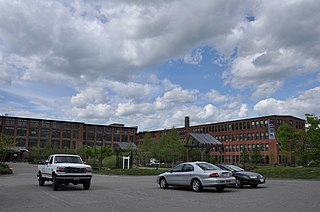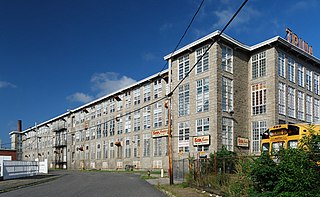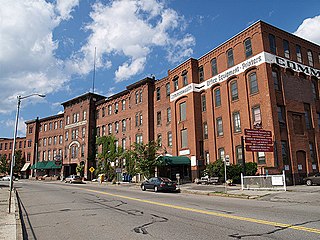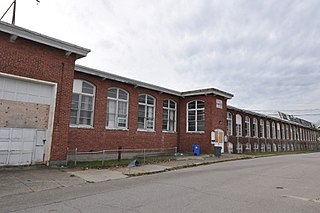
The Calvinistic Congregational Church is an historic church building located at 820 Main Street in Fitchburg, Massachusetts. In 1967, the congregation joined with the First United Methodist Church of Fitchburg to form a cooperative ministry called Faith United Parish. Built in 1896. the church was designed by architect Henry M. Francis, and is one of the city's finest examples of Richardsonian Romanesque architecture. It was added to the National Register of Historic Places in 1979. Since 2013 the building has been owned by the Casa De Gracia y Restauración.

The Fitchburg Historical Society is a historical society whose mission is to collect, preserve, and present the history of Fitchburg, Massachusetts. The society was founded in 1892, and is now headquartered in the historic Phoenix Building at 781 Main Street. The society's original 1912 headquarters building, designed by architect H. M. Francis, was listed on the National Register of Historic Places in 2003. The society operates three days a week and is open from 10am to 4pm Mondays and Tuesdays with a longer day on Wednesday from 10am to 6pm. They offer genealogical research, a library of local history, and numerous volunteer opportunities.

The Parkhill Mill is an historic mill complex at 1 Oak Hill Road in Fitchburg, Massachusetts. Built between 1885 and 1915, it was one of three mill complexes of the Parkill Company, one of the city's largest employers of the period. The mill complex was added to the National Register of Historic Places in 2008. The complex has been restored and is used by a variety of public and private businesses, and as residential space.

The Algonquin Printing Co. is a historic industrial complex at 1 Middle Street, off Bay Street in Fall River, Massachusetts. Developed beginning in 1891, it was the last 19th-century printing operation to be established in the city. The surviving main building was built in 1902, and the company operated on this site until 1941. It was listed on the National Register of Historic Places in 1983.

Sagamore Mills No. 1 and No. 3 are two historic textile mills on Ace Street in Fall River, Massachusetts. Built in 1888 and 1908, they form part of one of the city's single largest textile operations of the late 19th century. Mills No. 1 and 3 were added to the National Register of Historic Places in 1983, with a separate listing for Mill No. 2, located nearby on North Main Street.

Sagamore Mill No. 2 is an historic textile mill located at 1822 N. Main Street in Fall River, Massachusetts. Built in 1881, it is the oldest surviving mill of three built by the Sagamore Mill Company, one of Fall River's largest textile operations. The mill complex was added to the National Register of Historic Places in 1983.

Sanford Spinning Company is an historic mill complex located on Globe Mills Avenue in Fall River, Massachusetts. It was added to the National Register of Historic Places in 1983, along with the adjacent Globe Yarn Mills #3.

King Philip Mills is an historic cotton mill complex located at 372 Kilburn Street in Fall River, Massachusetts. Developed between 1871 and 1892, it was historically one of the city's largest mills, and its building inventory is still largely complete. The complex was added to the National Register of Historic Places in 1983.

The Cohannet Mill No. 3 is an historic textile mill located at 120 Ingell Street in Taunton, Massachusetts. The mill was built in 1890 and added to the National Register of Historic Places in 2006. It is the only remaining mill of the Cohannet Mills company, founded in 1847 for the manufacture of fine cotton yarns.

The Arlington Mills Historic District encompasses a major 19th century textile manufacturing complex in Lawrence and Methuen, Massachusetts. Developed between 1865 and 1925, it was one of the state's largest textile operations at its height. At the time of its listing on the National Register of Historic Places in 1985, the mill complex was owned by Malden Mills.

The North Canal Historic District of Lawrence, Massachusetts, encompasses the historic industrial heart of the city. It is centered on the North Canal and the Great Stone Dam, which provided the waterpower for its many mill complexes. The canal was listed on the National Register of Historic Places in 1975, while the district was first listed in 1984, and then expanded slightly in 2009.

The Washburn and Moen North Works District encompass an industrial complex that housed the largest business in Worcester, Massachusetts in the second half of the 19th century.

The Contoocook Mills Industrial District of Hillsborough, New Hampshire, encompasses the industrial mill complex of the Contoocook Mills, a major business in the town from the 19th century to the mid-20th century. Industry on the banks of the Contoocook River in Hillsborough began as early as 1763, when a sawmill and gristmill were operated in the area. More modern industrial activity began in 1828 with the construction of a cotton mill by Josiah Marcy. This three story timber frame building stands on the south side of Mill Street, on a granite foundation through which a raceway provide the water which powered the mill. Marcy expanded his operations, building a grist mill and saw mill before his death in 1848. The grist mill, a handsome brick building on the north side of Mill Street, was operated as such until 1884, after which it was converted into the picker building for the main mill complex.

The Hoyt Shoe Factory is a historic factory complex at 470 Silver Street and 170 Lincoln Street in Manchester, New Hampshire. It consists of two once-identical four-story brick factory buildings which face each other across Silver Street. Built in the 1890s, they housed the city's largest shoe manufacturer, an industry that gained in significance as its textile industry declined. The complex was listed on the National Register of Historic Places in 1985.

The Hillsborough Mills are a historic textile manufacturing complex at 37 Wilton Road in western Milford, New Hampshire, near its town line with Wilton. The oldest buildings of the brick mill complex were built in 1866 as a carpet-making operation. This business failed in 1874, but the complex was acquired by other textile interests, and eventual saw success producing carpet yarns, and blankets for horses and bedding. The mills were closed in 1970, and have since been adapted for other uses. The complex was listed on the National Register of Historic Places in 2014.

The Queensbury Mill is a historic mill building at 1 Market Street in Somersworth, New Hampshire. Built in 1884, it is unusual for the period for its wood-frame construction, and for its financing, executed by local businessmen to attract shoe manufacturers to the city. The mill was listed on the National Register of Historic Places in 1987. The building has been converted into apartments.

The Nashua Gummed and Coated Paper Company Historic District encompasses a collection of former industrial buildings on the north side of the Nashua River in Nashua, New Hampshire. Located on Franklin and Front Streets west of Main Street, the complex was developed by the Nashua Gummed and Coated Paper Company, later the Nashua Corporation, beginning in the late 19th century. It was a major manufacturing and employment center for the city until mid-1990s, when the company's business declined. One of its former storehouses was converted to residences in the 2000s, and the main complex is, in 2015-16, undergoing the same process. The complex of surviving buildings was listed on the National Register of Historic Places in 2015.

The Naushon Company Plant is a historic textile mill complex at 32 Meeting Street in Cumberland, Rhode Island. First built in 1902-04 and enlarged over time, it illustrates the adaption of the site to differing uses between then and the 1950s, when its use for textile manufacture ended. The complex was listed on the National Register of Historic Places in 1978.

The Michigan Paper Company Mill Historic District, also known as the Plainwell Paper Company Complex, is a complex of industrial buildings located at 200 Allegan Street in Plainwell, Michigan. It was added to the National Register of Historic Places in 2011.

The J. R. Montgomery Company Industrial Complex is a historic factory complex located on an island between the Enfield Falls Canal and the Connecticut River in Windsor Locks, Connecticut. It is next to the Windsor Locks Canal State Park Trail. The site has been listed on the National Register of Historic Places since 2017.























